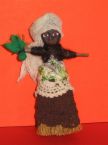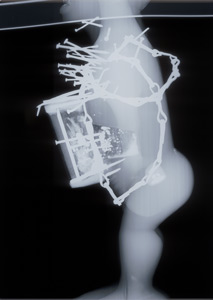The voodoo doll:
Creation: A Voodoo doll is either made by a Voodoo Queen or Doctor or a specialist is commissioned by a Voodoo Queen or Doctor to create a specific doll. This can only be done after the spirits have been invoked and have given their consent to the creation of this doll. However, a simple google search nowadays will bring you a huge quantity of 'one of a kind' dolls, mass produced for the influx of tourists New Orleans normally receives. The Voodoo Museum in New Orleans recommended that I contact The House of the Seven Sisters, who produce semi-authentic Voodoo dolls. Unfortunately, they never answered me.
Materiality: Everything about the materiality of a voodoo doll seems to physically mirror changing someone. They are most filled with soft cotton that is bendable and covered in cloth. In contrast, the pins are sharp and easily pierce the doll, without any effort. This lack of particular effort seems to present the targeted person as weak and very manipulatable. Louisiana dolls have no specific material requirements, although they are often stuffed with moss (the type used to fill mattresses). However, cotton, straw and old rags could also be used. There is far less rigidity in its materiality, however, many items of the doll are specific to the spirit to be invoked. The colour, for instance, can help attract a certain desired spirit, as the food arranged around the doll can. The cloths used are often very vibrant and fully resemble human clothing.
One of the reasons the materiality of the doll is so little developed may have to do with its origins. Because it evolved in slave quarters, it can be assumed that, in general, slaves did not have access to the best materials or the time to best use said materials. Therefore, the artistic value of the doll may have lessened. Furthermore, if these dolls were mostly effigies of slave masters, then perhaps beautifying them was not the primary goal of the slaves.

In the above example, the doll is extremely anthropomorphic, wears miniature human clothes and has basic human features. It is mostly made of cloth, and is very small.
The Minkisi:
Creation: Because Minkisi were community objects, the names of the individuals who created them are not known. However, the chief, nganga, and a sculptor normally worked on the creaton of an nkisi, the former bringing spiritual knowledge and the later providing construction skills. Most important Minkisi were created in an isolated, temporary place. The chief also created the pocket to be filled with the crucial medicines, such as herbs, fur, or seeds. The bundles are either attached around the neck of the figurine, or directly incorporated into its body; an empty hole in the place of a stomach can act as a medicine bundle.
Nsemi Isaki, in the 1900s, describes the sculptor's process of creation:
"In the past, when men carved figures they would first look closely at someone and then accoring to their skill cut down a tree suitable for carving. A carver would put eyes, ears, nose, mouth, neck as he had observed them. When he had prepared these features, if he had represented the person correctly, then it would look like him. For that reason they first shape the face and the whole head and neck and then finish the lower part."
Materiality: The materiality of a Nkisi can be viewed in two parts: what is intrinsic and what is added. The later is crucial for a Nkisi to actually become that-- without the medicine pouch created by the chief, it does not have power. Often, a sculptor must make a wooden figure without knowing what type of Nkisi it was destined to be. However, when the Nkisi was meant to resemble a specific person, the sculptor did know. The sheer quantity of material present on the average Nkisi is astounding, and even more astounding for a Nkondi.
In accord with the BaKongo view of humans and Minkisi, the medicine pouch is but a worthless container until it is filled. The 'medicine' was a metaphorical, or spiritual type of medicine-- it had no direct medicinal healing value. These included animal, mineral and vegetable materials. A material from a place where a spirit roams, such as stones from a graveyard or white porcelain clay from a river where the Water spirit may reside, are also frequently used. One of the items present in the pouch was a bodily link, like nails or hair, to the nganga who was overseeing the ritual. In a classic thing- changes- human- and- then- changes- thing, medicine is also incorporated in the body of the client. Tokens were put in the Nkisi, and the client drank potions and had lotions rubbed on his body.
X-ray of a Nkisi which shows magnetite crystals located inside the pouch in the stomach:

The list of materials frequently found in a medicine pouch was compilled by Nsemi Isaki in the 1900:
- Luyala (a fruit) - to hope that the nkisi may rule.
- Kala zima (charcoal) - to encourage the Nkisi to extinguish (zima) witchcraft.
- Mpezomo (copal resin) - in hope that the Nkisi's lightning will blind the witches.
- Lutete (gourd seed) - that it may cut down.
- Muzazu (a cocoon) - that it may stitch together.
- Lufulangi (a fruit tree) - that it may resuscitate.
An American missionary in 1902 wrote that the Minkisi were "decorated with strips of cloth and feathers, often with a bit of mirror set into the belly, behind which is the bit of rubbish containing the potent power. It is often a small sack made of pineapple fiber containing bits of stone, bird-claw and feathers, powder, pepper, bits of snakeskin, etc.”
Back to The Voodoo doll
